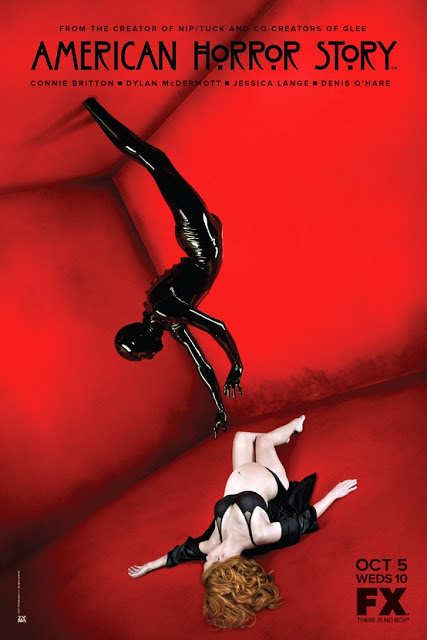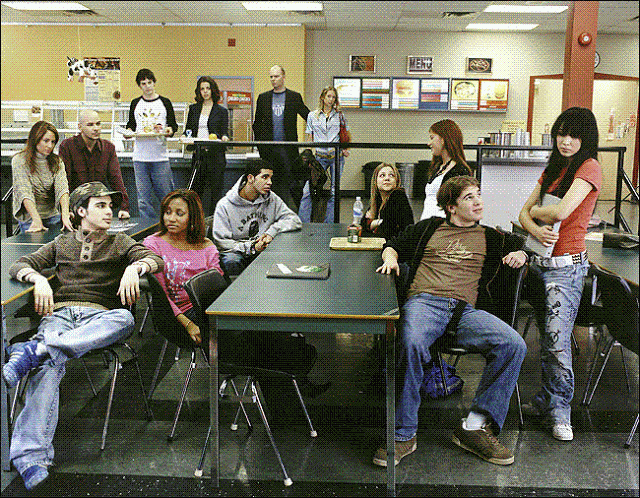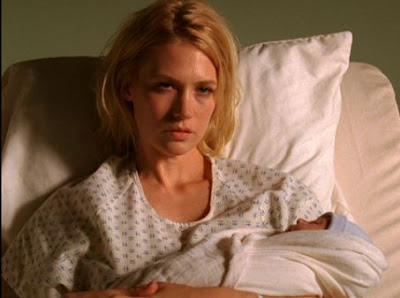American Horror Story co-creators Ryan Murphy and Brad Falchuk wanted to create a TV series that truly scared people. And they’ve definitely succeeded in their goal. But why the hell are they so afraid of abortion and women’s reproduction?
Tag: Abortion
Reproduction & Abortion Week: Juno
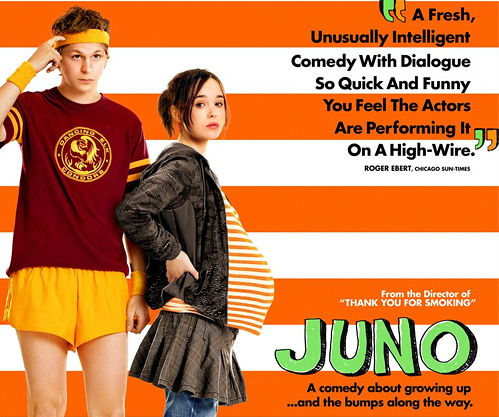 |
| Juno |
Anti-choice activist Jill Stanek declares Juno “the movie pro-aborts will hate,” describing the film’s scene at the abortion “mill” as “hysterical” and the protestor outside the clinic as a “friendly” student with whom Juno engages in “civil conversation.”
In contrast, there are those who argue that by virtue of the film being about Juno’s decision, it is inherently in favor of choice. Pro-choice writer Emily Douglas writes that she enjoys the way Juno normalizes teen sexual activity and, while still describing it as a “suburban fairy tale,” also suggests that “It’s a film for the people who love the many imperfect ways families take shape and people grow up.” Even Ellen Page, the actress who played the title character, proclaimed her own pro-choice credentials: “I don’t want white dudes in an office being able to make laws on things like this.”
There are other issues, of course. Sociologist Arthur Shostak neatly summarizes the movie’s many shortcomings from a pro-choice perspective: an empty parking lot at the clinic, a single, non-threatening protestor outside, an unprofessional over-sharer for a receptionist. Additionally, I have previously written about the many problems I see with Juno’s depiction of adoption. When Juno asks for an “old-school, closed adoption” and the potential adoptive parents readily agree, no one is recognizing the fact that openness in adoption has long-term benefits for not only birth parents, but also adoptees and adoptive families; when Juno rides her bike off into the sunset, she is indeed perpetuating the anti-choice fairy tale that adoption is without grief or long-term consequence of any kind.
The scene at the abortion clinic is an unequivocal disaster; the adoption story is messy and unrealistic; the happy ending is too easy, too over simplistic, too sweet for our sassy heroine.
So why, as feminists, do so many of us love this film in spite of all that?
I view the film as seeing the world through Juno’s eyes. It’s a cartoonesque version of reality, where people talk a bit like Juno and not quite like they do in real life, where characters are parodies and caricatures of stock types, and where there’s a teenager’s desire for what’s right and wrong to be obvious in a messy situation.
 |
| Juno at the abortion clinic |
Because, in many ways, Juno is a heroine for choice. Her independence is impressive – she doesn’t consult her parents until she’s already made her choice, decided against abortion, found adoptive parents, and arranged a time to meet with them. She makes the plans on her own and then tells them she’s looking for their support (which she receives) but not their permission. For a young woman, that’s exceptionally self-aware and downright empowered.
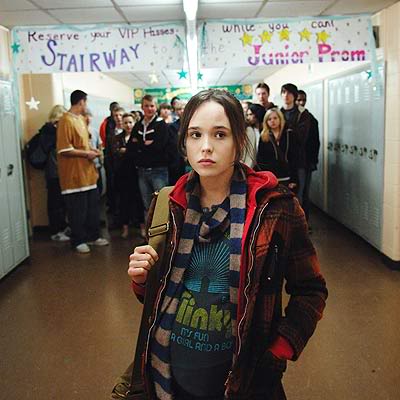 |
| Juno in high school |
 |
| Juno and Paulie |
———-
Gretchen Sisson is a sociologist and writer whose work focuses on reproductive justice broadly and teen pregnancy, young parenthood, adoption, abortion, birth, and infertility specifically. You can find her on Twitter @gesisson.
Reproduction & Abortion Week: Dirty Dancing
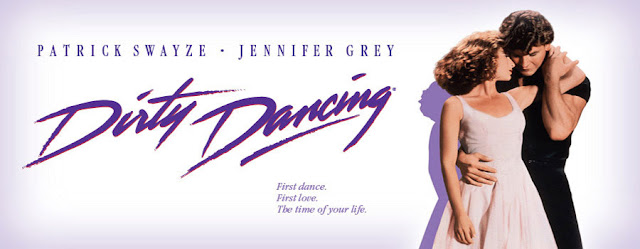 |
| Dirty Dancing |
This is a guest post by Meghan Harvey.
Most women I know around my age (whether liberal or conservative) all agree that despite their personal feelings on abortion, that a woman has the right to choose. Most women all agree, it’s better legal. By better of course, I mean safer.
Part of growing up in this post Roe v. Wade world meant that for us the picture painted of life before Roe v. Wade was different. A world that existed before we were born and it was not a pretty one. No movie or pop culture moment painted that picture clearer than the 80s classic, Dirty Dancing.
For most girls my age it was the first time we saw what “abortion” meant in the days before Roe v. Wade. It was simply “a dirty knife and a folding table.”
For those of you who are not familiar with the legendary movie, here is the main gist of it in a nutshell. Dirty Dancing takes place in upstate New York’s Catskill Mountains in 1963. Frances “Baby” Houseman is visiting Kellerman’s summer resort with her family for the summer before starting college in the fall. Baby, a rich privileged girl with a strong sense of right and wrong, meets Johnny the dance instructor from the wrong side of the tracks with the heart of gold.
When Penny, Johnny’s dance partner, finds herself pregnant Baby steps in to take her place on the dance floor while Penny has a back-alley abortion that almost kills her. Not only does Baby cover for Penny, she also gets the money to pay for the abortion from her Dr. father (without telling him what it’s for).
Many of you who have seen the movie a hundred thousand times like I have may very well be reading that description and realizing that the abortion storyline, though not actually the main part of the movie, is the cornerstone of the movie. Without it there is no movie.
 |
| Penny, after discovering she’s pregnant |
In fact the film’s screenwriter and producer Eleanor Bergstein was asked by a potential national sponsor (an acne cream company) to remove the abortion storyline from the film out of fear of a backlash and protests. Bergstein told them, “Oh, I’d be so happy to, but as it happens, it’s so into the plot that if I took it out, there’s no reason for Baby to learn to dance. There’s no reason for her to dance with Johnny, to dance at the Sheldrake, to fall in love with him, to make love with him, so the whole plot falls apart, so I can’t do it.” The sponsor pulled out and the abortion stayed in.
An abortion to most of us was an icky medical procedure. You went to a doctor and had it done, end of story. I for one was still too young to understand the moral debate or logistics of abortion, just that it was something that happened.
Dirty Dancing opened an entire generation’s eyes to the fact that it had not always been that simple. For the first time we were seeing it described as being done by a man with a “a dirty knife and a folding table.” Penny’s screams are described as being heard all the way down the hall.
Those screams in Dirty Dancing were the first time my generation would hear those screams and understand that the right to choose was not something that had always been ours. It was the first time that we opened our minds to the reality that illegal abortions were deadly, dangerous and horrific. Suddenly to a generation of young girls the protests outside abortion clinics that were so prevalent at the time seemed different. Suddenly it occurred to us, in the simplest way, that these people protesting must not have seen Dirty Dancing.
They must not have seen the Pennys of the world. Women who didn’t have health insurance, support, or a job with maternity leave. Women who didn’t even the money for an abortion, let alone to give birth to a child. Penny was not perfect, but she was not an evil harlot either. She was a woman in a hopeless situation with no choices. Not that different than our aunts, big sisters, or even our moms. In another time, we could have been Penny. But on some level, my generation understood that part of the message of the movie was just that. No, we would never be Penny. Our generation would never have to face the dirty knife and folding table down the hall. We were the lucky ones, and Dirty Dancing ensured our entire generation understood that.
Eventually that first experience of what a back-alley abortion actually was would help us understand later that the debate raging was much more simple than Women’s Rights. Much less official than Roe v. Wade. Dirty Dancing made that first picture of abortion something that had nothing to do with moral or constitutional implications. There is no discussion in Dirty Dancing about when a fetus becomes a life. In fact Baby’s father, the Doctor, never says one word about whether abortions are right or wrong, just that they are illegal.
This debate was about our lives.
A few years after Dirty Dancing came out I entered high school and took a debate class. One of my first debates was debating whether Roe v. Wade should be reversed or not. I stood up in front of my class and described in detail what a back-alley abortion was. I explained how it was the leading cause of death for young women before 1973. I told the story of the real Pennys of the world. I won the debate.
I have a vintage Dirty Dancing shirt that I like to wear. On the back it has the most famous line from the movie, “No one puts Baby in a corner!” Though what that line means to each one of us may differ, as an adult today I can’t help but think that it’s a line symbolic for all women. It sums up the lesson on abortion that is told throughout the movie.
Our lives mean something. Our choices mean something. And we do not deserve to be pushed into a dark corner to sit quietly. Its not just Baby, it’s all of us.
None of us deserves to be put in a corner.
———-
Meghan Harvey is a blogger, New Media Manager, Mom, and 80s movie obsessed women out the Bay Area. She contributes to SheHeroes.org, Life360.com, MOMocrats, and her personal blog Meg’s Idle Chatter. You can find her on Twitter at @Meghan1018.
Reproduction & Abortion Week: Melodramatic Clichés and Missed Opportunities: Lori’s Pregnancy in ‘The Walking Dead’
 |
| The Walking Dead |
When Lori finds out that she’s pregnant, she doesn’t know whether the father is Rick or Shane. No judgment; it’s a crazy zombie world and she’s been getting along the best she can. She contemplates ending the pregnancy and procures some emergency contraceptive pills in the hopes that they’ll do the trick. (Of course, morning after pills are not abortion pills, and both Lori and the show’s producers are aware of this. Yet that doesn’t stop them from perpetuating harmful misconceptions about emergency birth control, as Megan Kearns astutely points out in her Bitch Flicks piece on The Walking Dead.) But no sooner does Lori down the pills than she abruptly changes her mind and vomits up the offending medication. Only then does she confess the truth of her pregnancy to her husband Rick, who unequivocally declares the child his own, and is angry at her for even considering an abortion.
Let’s be frank. Lori’s choice not to end her pregnancy is not intelligent. It doesn’t make rational sense within the context of the show. Moral and emotional factors aside, having the baby is the least reasonable choice Lori could make. Being in the late stages of pregnancy will drastically diminish her chances of surviving a zombie attack. And what happens after the baby comes? A wailing, helpless newborn infant could be a potentially deadly liability. Lori has ample reasons to put aside her feelings and do the logical thing, for the sake of her own survival.
Of course, these difficult choices are never based purely on reason. The problem in The Walking Dead is that Lori is a frustratingly underdeveloped character. So it’s never quite clear exactly what other factors are contributing to her decision. What are her values, her priorities? All we really know about Lori is that she constantly changes her mind for no apparent reason. For example, at the very start of season 2, she firmly tells Shane to stay away from her and her son Carl (pretty justifiably, since at the end of season 1, the man did attempt to rape her.) Shortly after that, she’s angry at the same man for wanting to leave the group. It’s fair to say that Lori’s behavior is wildly inconsistent. It’s difficult to glean a distinct set of character traits or values from her actions. So when she chooses to reject the morning after pills, it’s impossible to know exactly why. Beyond the generic assumptions that “life is precious” and “babies are good,” there is no sense that Lori’s choice arises inevitably out of who she is.
So rather than illuminating Lori’s character or highlighting the moral and ethical dilemma she faces, Lori’s decision exists mostly to heighten the dramatic tension of the story — that is, to heighten the tension among the men. The pregnancy of uncertain paternity is a well-worn trope of high melodrama and a staple of the soap opera. In The Walking Dead, it’s used to deepen and harden the conflict between Rick and Shane, which is the backbone of the second season. The pregnancy provides a further wedge between the men, strengthening Shane’s belief in his own claim on Lori. It also motivates Rick to seek long-term refuge at Hershel’s farm. So Lori’s ultimate decision is less about Lori and what she wants or needs or believes, and more about creating melodrama among the men.
At its core, the rivalry between Rick and Shane is a regressively sexist contest for alpha male status. In her piece on sexism in The Walking Dead, Megan Kearns outlines the outdated gender roles depicted on the show, including how the characters openly and fiercely reinforce the gender-based segregation of labor. Men do most of the dangerous, active tasks, while the women of the group do the domestic tasks.
Now it does make a certain amount sense that either Rick or Shane would lead the group, since they both have experience as lawmen. The skills of a sheriff’s deputy would definitely come in handy during a zombie encounter. But what qualifies them to make decisions about where the group will go next, and what it will do in the long term? Being former sheriff’s deputies doesn’t provide them any special insight into the nature of the post-apocalyptic world. Yet the show operates on the unquestioned assumption that the group needs an alpha male to lead it, and that man will be either Rick or Shane.
But the clash between Rick and Shane isn’t just a contest over who can keep the group safe. Shane asserts repeatedly that on a deeper level it’s a struggle for possession of Lori, Carl and the unborn child. Making the rivalry fundamentally about custody of Lori and the unborn baby cheapens the conflict. There is potential for a thought-provoking philosophical dispute over the need to sacrifice civilization in the name of survival. Is survival even worthwhile if civilization must be abandoned? While the characters pay a lot (a very lot) of lip service to these issues, the potentially fascinating debate takes a back seat to shallow machismo when the writers distill the conflict into two men fighting over a woman.
Essentially, Lori keeps her baby so that the men have more to fight over, and The Walking Dead misses a real opportunity to explore a rich, provocative theme. Even without addressing the morality of abortion, Lori’s predicament goes to the larger philosophical conflict that supposedly drives the whole season. Can people fighting for survival afford to have morals? How do people react when their right-to-life principles are tested? In the real world, it takes a lot less than a zombie apocalypse for a pregnant woman in crisis to realize that her ideals and her reality may not blend well. But here we have a whole other layer of considerations, none of which get discussed or explored at any length.
How much more powerful and dramatic would it have been if Lori really wanted to keep the baby, but ultimately had to decide that she couldn’t? Or perhaps the opposite – maybe she could have initially been determined to abort, but decided that it would be better to risk death than give up on her ideals. At the very least there could have been an interesting conversation or two about it.
Instead, the show backs away from real-world controversy and gives us a lot of soap-operatic, male-driven melodrama. And once again, a woman’s very intimate predicament simply serves as fodder to motivate and drive the male characters’ stories.
Rebecca Cohen is the creator of the webcomic “The Adventures of Gyno-Star,” the world’s first (and possibly only) explicitly feminist superhero comic.
Reproduction & Abortion Week: When Abortion Was Illegal
This piece on When Abortion Was Illegal, by Amber Leab, originally appeared at Bitch Flicks on June 17, 2009.
———-
In this 1992 documentary directed by Dorothy Fadiman, women (and men) tell their stories about illegal abortions, reminding us of the necessity of safe and legal access for women.
The film was nominated for an Academy Award for Best Documentary Short in 1993, and is the first in a three-part series about abortion in America.
The other two films in the series, From Danger to Dignity: The Fight for Safe Abortion and The Fragile Promise of Choice: Abortion in the U.S. Today, are also available for free online.
Reproduction & Abortion Week: Mother and Child
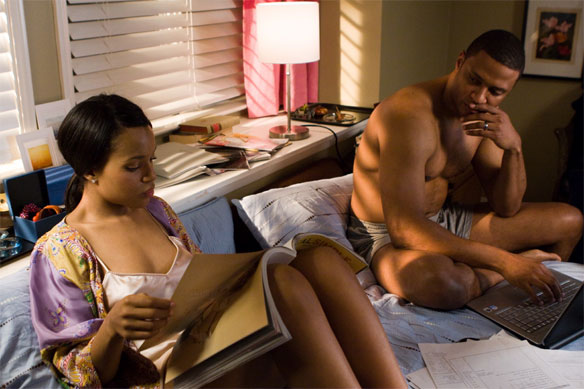 |
| Kerry Washington and David Ramsay in Mother and Child |
 |
| Shareeka Epps as Ray in Mother and Child, along with Washington |
Annette Bening stars as Karen, a woman who remains deeply affected by the baby she gave up for adoption as a pregnant teen. At 50 years old, childless, and significant other-less, Karen begins to feel the emptiness of the child she once carried. As she continues to take care of her dying mother, Nora (Eileen Ryan), who encouraged her decision to give her child to another, she feels her first pangs of regret exacerbated by years of resentment.
 |
| Annette Bening as Karen in Mother and Child |
Part of that recovery to self is attributed to Jimmy Smits’ character Paco, Karen’s reluctant love interest, who sees more in Bening than she sees in herself. While Smits is very subtle in this role, the gentleness he brings to Paco is one that few critics remarked on but was pivotal to the emotional compass of Karen’s character (but does not define it).
 |
| Bening with Jimmy Smits as Paco in Mother and Child |
To me, this is Washington’s best performance to date, and it—as well as this film—goes entirely unnoticed, which is a crying shame. Her portrayal is crushing, real, and simply mesmerizing to watch unfold. The only comparable performance I can think of is that of Jennifer Garner in Juno, another performance that fell right through the critical cracks.
 |
| Samuel L. Jackson and Naomi Watts in Mother and Child |
As a matter of fact, Lucy and Joseph are really the only married couple in the movie who are shown having sex. Though Lucy and Joseph don’t exactly have a happy fairy tale ending, at least we get to see a black couple getting busy. So yes, Hollywood, two black people do have sex. Passionate, unapologetic sex in a committed relationship, and it’s about time we see that again.
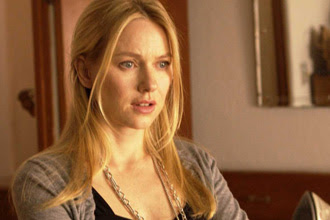 |
| Naomi Watts as Elizabeth |
This brings us to Naomi Watts’ Elizabeth, whose role we don’t fully learn until nearly the end of the movie. She touchingly steers the film full circle. But Elizabeth is a woman who’s suffering from bouts of desolation as an emotionless attorney at a law firm. She gets involved with Samuel L. Jackson’s character, Paul, a fellow attorney, and what happens next can only be described as a full realization of her own character, which leads her to make a decision that will not only change her life, but also Paul’s. This is the perfect role for Watts, whose quiet ferocity works well here simply because she tries to remain in such tight control of her life that when it begins to blossom, we finally get to see her heart.
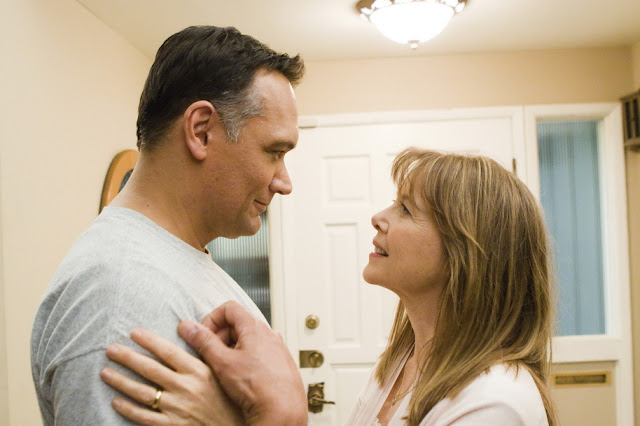 |
| Smits and Bening |
Alluring, delicate and simply exquisite to watch, Mother and Child tackles the inspiring and sometimes heartbreaking aspects of motherhood with a range of characters in which every woman, whether or not she’s a parent, can see themselves. Perfectly intertwined stories yield a gorgeous singular concept of love and maternal grace that steals your heart.
Reproduction & Abortion Week: 16 and Pregnant: Degrassi and Abortion
This is a guest post by Lee Skallerup Bessette.
I realized very quickly however that there would be a number of challenges in writing about these episodes (Spike’s pregnancy in Degrassi Junior High, Erica’s abortion in Degrassi High, and Manny’s abortion in Degrassi: TNG): untangling my emotional connection to the show and dealing with the different history of abortion and reproductive rights in Canada. While a co-production with WGBH (the Boston PBS affiliate), this show was about as Canadian you could get in terms of its look and attitude toward all of the issues dealt with.
(For an excellent analysis of how Degrassi has become less Canadian, read Amy Whipple’s insightful post.)
In 1987, when 14-year-old Spike was having sex with her boyfriend at a party, the Supreme Court of Canada was getting ready to rule that the current laws limiting access to abortion (a panel of three doctors needed to approve the procedure in a hospital setting) were unconstitutional. This was brought before the court by Dr. Henry Morgentaler, who had been brazenly flaunting the law since 1973 in Quebec. Dr. Mongentaler had been unsuccessfully brought to trial three times in Quebec; the juries in each case had been unwilling to convict, leading the government to declare the law unenforceable. The CBC has an excellent digital archive of news footage and interviews of Morgentaler and his cases in the courts.
In 1989, when 16-year-old Erica was getting an abortion because of a fling at summer camp, Chantal Daigle was fighting for the right to terminate her pregnancy against the wishes of the father. Once again, this case originated in Quebec and made national headlines. The case was expedited all the way to the Supreme Court of Canada, who ruleD in Daigle’s favor. Daigle had already obtained a late-term abortion in the United States when the ruling was handed down. It was seen as a victory for women’s reproductive rights in Canada. Although there were a number of attempts, there are currently no laws in Canada governing abortion.
I vaguely remember, as an 11 and 12 year old, the Chantal Daigle case, but I have absolutely no memory of the Morgentaler case. It’s notable that both these cases originated in Quebec, in particular the unwillingness of three Quebec juries to convict. After the tyranny of the Catholic Church ruling over the province for approximately 150 years, the 1950s, with the Quiet Revolution, and the 1960s, with everything that came along with that, saw the outright rejection of any and all Catholic religious influences. Including their disapproval of abortions. As a result, I grew up in an environment that while not embracing abortion, at the very least it was treated as being not a very big deal.
(It should also be noted that the period when Morgentaler was being brought before the courts in Quebec, the Separatist movement was gaining popularity, and thus there may have also been some residual resentment towards the federal government leading to the refusal to convict.)
I know this, so far, has read like a long history lesson cribbed for Wikipedia; it is. But it’s important to contextualize the culture in which these shows were being produced and in my case, consumed. For instance, I didn’t understand why Erica, when visiting the abortion clinic, was aggressively confronted by pro-life demonstrators, waving a plastic fetus at her (go to the 4:30 mark). This was more common in the rest of Canada, as compared to Quebec. But these types of protests outside of abortion clinics were common, even in Canada.
Notably, it’s Erica’s twin sister Heather who is scarred by the ordeal, and she has nightmares about the protests. But it is also Heather who stands beside her sister, as well as stands up for her sister when Erica receives threats from a pro-life student at Degrassi. What’s interesting is that the storyline isn’t wrapped up at the end of the two-part premiere (the abortion was one of the main storylines for the premiere episodes of the “new” Degrassi High series); it continues on across the entire first-half of the season, in the same way Spike’s decision to keep baby Emma is dealt with throughout the show’s run. The arguments are nuanced and the kids are treated with respect. The pro-life side is seen as being the destructive force, bullying, scaring, and shaming, while Spike puts it best: “It’s great to have high ideals and stuff, but when you’re in that situation, right and wrong, they can get really complicated.”
Fast-forward to 2004. Degrassi: The Next Generation (or TNG) has been airing on CTV in Canada and The N (originally Nick Teen) in the United States for three and a half seasons. The new iteration of the show started with Spike’s daughter Emma starting junior high herself. Emma’s best friend Manny, midway through season 3, who is trying to change her image from good girl to party girl, gets pregnant. She, too, struggles with what to do, eventually opting to get an abortion. Emma, at first, doesn’t approve of the decision, being the child of young, single mother herself. Spike once again offers wise council, telling Manny to do what is best for her. This upsets not only Emma, but also Craig, the father. Ultimately, Manny (who is identified as Filipino) goes to her mother and is surprised to receive her support, even taking Manny to get the abortion.
This was another two-part episode and it initially didn’t air in the United States. 2004 was during the height of the so-called Culture War in the US, while Canada still maintained a more open and liberal position on abortions. The article linked just above points out that, unlike most shows about teens that were airing at the time, Degrassi: TNG had the courage to take abortion seriously and handle it realistically; neither Manny nor Erica conveniently lose the baby, thus avoiding the reality of having to get an abortion. In both cases, the rights of the mother are given priority; even the women around them who may disagree with their decision ultimately defend the right to choose. And, as pointed out by Sarah, a blogger at Feminists for Choice, each girl goes on to have rich and varied (if, at times, melodramatic) storylines; Manny eventually lives her dream of becoming an actress, while we see Erica briefly during Degrassi: TNG looking happy and fulfilled (and notably not at all in distress when holding someone else’s baby).
So what, then, can we learn from this particularly Canadian perspective on abortion? Certainly, the idea of a woman’s right to choose is forefront in each portrayal, but it doesn’t trivialize the decision, either. The characters are shown dealing with the aftermath of the abortions, but not in a sensational way, either. In fact, it is often those around them who have the most difficulty with a profoundly personal decision. The bullying and shaming methods often used by the pro-life movement are shown as being ultimately counter-productive, both in the late 1980s and in the mid-2000s. Abortion, however, is just one decision in the long and full lives of these young girls, who are shown to go on and have relatively happy and fulfilled lives.
For that, I am glad that Canada has the history it has in regards to abortion, so that we may have these complex and ultimately, to my mind, satisfying portrayals of women’s reproductive rights.
———-
Reproduction & Abortion Week: Fingernails and Shmushmorshmins: Abortion and Privilege in ‘Knocked Up,’ ‘Juno,’ and ‘4 Months, 3 Weeks and 2 Days’
As abortion has become more accepted and less taboo in mainstream America—despite Republican lawmakers doing everything they can to appeal Roe v. Wade—films about pregnancies have had difficulty depicting its characters talking about or even considering abortion. If the movie is about pregnancy, and the journey that the characters take during the course of the pregnancy, then abortion would erase not just the main conflict, but the entire plot of the movie. You would be left with a twenty minute film about characters who neither grew nor changed, because we all know that having babies makes everyone into better-adjusted and more-fulfilled people. In 2007, two American comedies failed spectacularly in realistically addressing the issue of abortion, while a Romanian drama delivered one of the most stark and honest portrayals of a woman obtaining an illegal abortion.
Juno and Knocked Up were two of the biggest comedy hits of 2007, while 4 Months, 3 Weeks and 2 Days was completely ignored outside of the arthouse circuit. But both comedies not only do an awful job of treating abortion in a realistic manner, they completely ignore the privilege that their characters have, privilege that not only allows them to consider having a safe, legal abortion, but to decide instead to carry the fetus to term. Every decision that their protagonists make is driven by completely unacknowledged privilege, whereas the decisions that the protagonists of 4 Months, 3 Weeks and 2 Days make are greatly influenced by their lack of privilege. By comparing Juno and Knocked Up to the Romanian drama 4 Months, 3 Weeks and 2 Days, we see the enormous, and largely overlooked, impact that privilege has on both the decision to have an abortion and the decision not to.
 |
| Alison shopping for the baby in Knocked Up |
Knocked Up gives the most half-assed head nod to the idea of abortion possible and does not remotely recognize the role that class privilege plays in the decision to have a child. The protagonists of Knocked Up are Alison, an uptight TV producer who lives with her sister, and Ben, an unemployed, undocumented Canadian immigrant who spends his days getting stoned with his friends. The two meet at a bar and engage in a drunken one-night stand that, due to a communication error, does not involve contraception. When Alison discovers that she is pregnant, she is faced with a serious decision… kind of… but not really.
The idea of abortion is lazily floated in two scenes adding up to maybe a minute of the two-hour film. The only remarkable thing about these scenes is that throughout both of them nobody actually says the word “abortion.” While Ben bemoans his bad luck at having gotten a woman pregnant after deciding to have unprotected sex with her, his friends suggest plans of action. When Jonah makes the obvious suggestion that Alison simply “take care of it,” Jay is so outraged and offended by the mere idea of abortion that he refuses to let anyone say the word. From then on, Jonah says that what Alison should do “rhymes with shmushmorshmin.” Jay apparently is fine with people having premarital sex, but has deep moral conviction only when it comes to people dealing with the consequences of premarital sex.
Alison also has a very brief conversation about abortion with her mother, who makes very valid points about the impact it will have on Alison’s career. Even though Alison’s mother believes that Alison should get an abortion, saying that having the child would be “a big, big mistake,” she too does not say the word, also using the euphemism “take care of it.” Alison’s conversation with her blunt, critical mother is contrasted by the conversation Ben has with his jovial and supportive father. Ben’s father calls the pregnancy “a blessing,” and the implication is that his upbeat attitude is vastly preferable to Alison’s mother’s negativity.
Do we ever see Alison’s perspective on the issue? What are her thoughts on abortion, both as a legal concern and a personal one? Considering she seems like the type of person who had planned out her entire life, had she planned on having children, and if so, when? We do not see Alison deal with any of these questions, nor does she explain how or why she came to the decision to have her baby. Between the homophobic mockery and the jokes about how uptight and controlling women are, there is no room for serious discussion about abortion.
Nor, of course, is there room for Alison to acknowledge the privilege that goes in to making her decision. Despite not having her own apartment or house, Alison is very well off. She has a very well paying job that gives her financial freedom, a luxury that depressingly few in the United States have. In the flash of a second that abortion is considered, never is the question of whether or not Alison can afford the operation raised, likely because her job gives her health insurance that would cover such a procedure. The cost of raising a child is similarly never considered as a serious issue. Alison buys numerous books and various supplies without ever checking price tags or hunting for bargains. At one point, her sister Debbie offers to buy her a $1,400 crib without batting an eyelash.
In addition, Alison mentions that her employer, E!, will give her three months of paid maternity leave, so she will be able to give birth and care for her baby without having to worry about how she can afford to feed and clothe her newborn child. Alison is fortunate enough to work for a company with at least fifty employees, and to have been employed by them for at least a year. Otherwise she would not qualify for the Family and Medical Leave Act of 1993 mandate which requires companies to provide paid maternity leave for employees who meet the above conditions. This is just one of the many privileges that grant Alison the freedom to choose whether or not to abort her child without fear of any serious consequences except for “sacrificing [her] vagina.”
Juno tells a very different story about pregnancy, but still creates a remarkably ideal situation for its protagonist to make the issue of abortion and childbirth seem easier and free of life-changing repercussions. Juno is the eponymous protagonist of the film who, after losing her virginity, discovers that she is pregnant. Unlike Knocked Up, Juno spends a considerable amount of time debating whether or not abortion is the right decision for its protagonist to make, and gives us some insight into her thought process. The first person that Juno tells about her pregnancy is her friend Leah, and in the conversation that they have they both work under the assumption that Juno is going to abort the fetus. Compared to other teen pregnancy narratives that feature swelling music and melodramatic conversations, Juno’s discussions about abortion are straightforward, blunt, and reasonable.
 |
| Juno getting an ultrasound |
Yet after some deliberation, and actually going to an abortion clinic, Juno decides not to have an abortion. What changes her mind? When walking into the abortion clinic she has a conversation with a classmate who is standing outside protesting. Her classmate informs her that at this period in her pregnancy her “baby” has already grown fingernails, which seems to force Juno to reevaluate her decision. Ignoring not just the relevance of this fact, but the accuracy (fetuses develop fingernails between weeks ten and fifteen, while by Juno’s estimation she is in her ninth or tenth week), we at least see multiple discussions that influence the character’s thought process and lead her to her final decision.
But while Knocked Up was at least realistic in depicting the privileges that allows Alison to have and raise a child with as little stress as possible, Juno‘s portrayal of teen pregnancy creates a situation so ideal for its protagonist’s pregnancy that it borders on fantasy. After choosing not to have an abortion, Juno decides instead to give her baby up for adoption, and finds an attractive, white, upper-middle class couple looking to adopt her baby. That stroke of luck not only stretches credulity, it paints a far rosier picture of the adoption process than reality. In 2007, when Juno was released, 133,640 children in the United States were waiting to be adopted, including 1,674 in Minnesota, where the film takes place.
Of course, one way in which this remarkably easy adoption process is realistic is the role that white privilege plays, although this privilege is of course never acknowledged in the film. White babies are typically far more in demand than babies of color; of all adopted children in the United States in 2000, 64% were white, while white children made up only 40% of children in the Foster Care system. If Juno were black or hispanic, would it have been so easy to find a well-off couple to adopt her child? Statistically, no, and it is likely that her child would have ended up in the foster care system. In 2009 the median amount of time spent in foster care was 13.7 months, and over half of children that were removed from foster care were taken back in by their birth parents, compared to only 20% that were adopted.
The ease with which Juno finds a family to adopt her baby is steeped in privilege both realistic and otherwise, but that is not the only way that Juno’s pregnancy is made as easy as possible for the sake of the narrative. Juno is a high school junior during the course of the film, and makes no effort to hide her pregnancy in any way. We get no sense that she is ostracized, bullied, or shamed for her decision, either by her classmates or by the school itself. Nor do we ever see any indication that her pregnancy interferes with her school work. Considering that approximately 70% of pregnant teenagers drop out of school, it is fair to say that the miniscule impact that pregnancy has on Juno’s life bears little resemblance to the reality of teen pregnancy.
Knocked Up and Juno paint an unrealistically bright picture of how pregnancy can impact a woman’s life. Both films take advantage of privileges without acknowledging them and even invent privileges that their characters would likely not have in the real world. In doing so, they create situations in which abortion does not have to be seriously considered. By giving abortion short shrift these films allow viewers to forget how serious and important a woman’s right to choose is, and how serious the consequences would be for real women in the same situations as Juno and Alison if abortion were not an option. 4 Months, 3 Weeks and 2 Days makes a strong case for legal abortion by showing just how terrible it is in the real world to be faced with either having to bear a child or to obtain a legal abortion. The film stands in stark contrast to Juno and Knocked Up not only because it released in the same year as those two films, but because the film treats pregnancy and abortion as serious issues, not fun jokes.
Cristian Mungiu’s film is set in Romania in the late 1980s, when the country was still part of the Soviet Union. This is a very different setting than either Minnesota or Los Angeles circa 2007; milk is a luxury, gasoline is a rarity, and cigarettes are contraband. The protagonists of the film are college students, not mired in poverty or starving, but well off and stable. This disparity between what it means to be well off in the United States and what it means in the Soviet Union makes it clear how difficult living under Soviet rule was. Otilia is a young woman trying to help her friend Gabriela get an abortion. While for Juno this is as simple as making an appointment at a clinic and attempting to not be swayed by the lone, peaceful protester, for Gabriela it is much more complicated. She and Otilia must contact a man who performs abortions, make an appointment at a hotel, and borrow enough money from friends to pay for everything. Every step of the way they know that if they are caught they will be arrested and imprisoned.
Gabriela attempts to lie to the man performing the operation, claiming that she is in her second month, but he realizes that she is further along than that (she never says how far she is but we glean that the film’s title is referring to the actual answer). He refuses to perform the procedure after he realizes that Gabriela was lying and that she does not have as much money as he wants, but decides that in addition to the payment that he wants to have sex with Otilia. This is the sort of situation that women can find themselves in when legal abortion is not an option. Otilia is faced with the decision of either making her friend carry her fetus to term–which would result in the end of any sort of academic career and would likely lead to a life of poverty if the father refuses to support the child–or to prostitute herself for the sake of her friend. Otilia is raped so that she can help her friend, a circumstance that feels a universe away from the witty quips and hamburger phones that make up Juno’s life.
The procedure itself is dangerous and potentially life threatening. It involves the man inserting a probe filled with fluid into Gabriela’s vagina while she lies still from between two and forty-eight hours. The unspecified fluid induces a miscarriage, which causes Gabriela to bleed significantly as she births her stillborn fetus. The unsanitary location and lack of professional medical equipment make it likely that Gabriela will either bleed out or get an infection during the course of the procedure. However, in the film, the procedure works effectively and Otilia disposes of the fetus while Gabriela rests and recuperates.
 |
| Gabriela and Otilia from 4 Months, 3 Weeks and 2 Days |
Cristian Mungiu does not depict Gabriela’s abortion as relatively free of incident because he wants to portray this sort of illegal abortion as easy or simple. There are enough traumatic moments throughout the film to reinforce how dangerous and awful a backdoor abortion can be. Rather, the abortion itself is free of incident because Mungiu is making it clear that this is normal. We see Gabriela and Otilia mention other women who have had abortions, and they only find this man because he was recommended to them by a friend. In this society, illegal abortions are as common as legal abortions are in our society. But instead of going to a hospital or a clinic to have the operation done, women in Romania had to find people willing to perform the procedure in hotel rooms late at night, with the threat of imprisonment hanging over their heads the whole time.
For Juno and Alison, the decision to have a child is not easy, but it is simple. There is deliberation, and there is drama, and both of them consider their options carefully—although Alison mostly does so offscreen—but their choices are either to have a safe, legal abortion, or to have a safe, complication-free pregnancy and birth with a happy ending that involves for Juno giving the child to a well-off, stable woman, and for Alison raising the child in a well-off, stable household. Both films create characters and situations that are as conducive as possible to happy, healthy pregnancy and birth, and in some instances even strain the boundaries of reasonable possibility.
4 Months, 3 Weeks and 2 Days presents a character in a situation who has none of the advantages and privileges that Alison and Juno have. In our current political climate that seems intent on repealing every reproductive right women have gained over the last fifty years, it is important for us not to take the right to choose for granted, to treat it like a joke, or to discuss it with hushed tones and euphemisms, as if it is something embarrassing that no respectable, reasonable woman would do. By presenting abortion as the wrong choice, and pregnancy and birth as easy and spiritually fulfilling, movies like Juno and Knocked Up support the conservatives in the culture war, no matter how progressive they might seem to be. Movies with these messages are dangerous for women, because they drastically misrepresent reality, leaving it to low-budget foreign dramas to tell the truths that desperately need to be heard.
Reproduction & Abortion Week: Undesired
———-
———-
Martyna Przybysz is a Pole who resides in London, UK. She works in film production. This is her blog: http://martynaprzybysz.tumblr.com.
Reproduction & Abortion Week: ‘Where Are My Children?’
———-
Erik Bondurant is a political scientist and a film blogger at The Movie Review Warehouse and contributor to Sound on Sight, with a primary focus on the portrayal of politics, gender and sexuality in cinema.
Reproduction & Abortion Week: Mad Men and The War on Women, 1.0
It’s not easy being a lady in the working world today. We’re still fighting for equal pay for equal work, freedom from workplace harassment, and the right to decide what grows (or implants itself) in our uteruses. In all honestly, it’s not terribly different from the drama unfolding at Sterling-Cooper-Draper-Pryce every Sunday night, which is exactly the reason my baby boomer mother can’t stand Mad Men: “I lived it,” she says with exasperation, “why would I enjoy watching it over again?”
Do the liberal-arts educated, Anthropologie-clad millenials fawning over Betty Draper Francis’ silk scarfed bouffants see the irony my mom pointed out? As a card (or more accurately, BA) carrying member of the club, I’d like to say that we do. I’d be hard pressed to find a ladyfriend without a reproductive rights war story of her own, from sanctimonious pharmacists offering unprescribed admonitions to early morning drives across state lines to a clinic. While the scarier aspects of Mad Men-era reproductive health (Betty’s twilight sleep birthing experience from season three, for starters) seem like a far-off nightmare to today’s twentysomethings, neo-conservatives’ war on women makes it clear that such arcane threats may not be so distant.
| Betty awakes from her twilight sleep after giving birth to Draper’s third child |
 |
| Joan introduces her son Kevin to the office, and his father |
It doesn’t take much to beat Joan and Greg in the healthy relationships department, though. Shortly after introducing Greg, and depicting his less-than-chivalrous behavior, creator/writer Matthew Weiner blows the lid off Greg and Joan’s curious courtship with a maddening rape. Forcing himself on an unwilling Joan in her boss Don Draper’s private office, viewers come to understand Joan’s options: quietly endure sexual violence to be a respected doctor’s wife and mother, or continue in limbo as a single working woman with no respectable chance at a family. While it’s Greg who commits the rape, it’s the cultural castigation of single, working mothers that forces Joan’s hand, leading her into the arms of a sexual predator.
This same stigma precludes Peggy from motherhood, leading the (sometimes) Catholic secretary-cum-copywriter to go through with her pregnancy but put her child up for adoption. Resident Sterling-Cooper-Draper-Pryce cad Pete Campbell (runner-up to Dr. Harris for most egregious husband of the 20th century) is the father of Peggy’s child, sure to be the first in a line of many illegitimage offspring for the the account executive. Though their dalliance has little effect on Pete – with the exception of a few seasons’ worth of sidelong glances and shifty elevator rides between the two – Peggy’s determined resilience to continue her career unblemished is both a triumph and a tragedy. As one of the agency’s brightest creative stars, Don’s up-and-coming ingenue, Peggy conveys confidence in choosing her career over motherhood. But she isn’t without regrets, which she reveals to Don over diner coffee: “Do you ever think about it?” he prods. “I try not to,” Peggy reflects, “But it comes out of nowhere sometimes. Playgrounds.” The line is drawn out, mumbled, underscoring Peggy’s pain. Elizabeth Moss (who plays Peggy) told Vulture.com that it was her favorite line of the season, suggesting how strongly modern women relate to Mad Men‘s female characters.
 |
| Peggy and Don share grief, and coffee |
In Rosengate‘s aftermath, the conversation on working mothers is more fraught than ever. “’Working mother’ is a redundant phrase” is the neo-conservative right’s new mantra, and I won’t begrudge them the satisfaction of believing it. But let’s not pretend that the stay-at-home-mom is the equal of the working mother. It’s an affront to parents of all backgrounds: those with the luxury to choose an at-home parent over a second income and those whose finances dictate the decision. Mad Men‘s place on the cusp of this working mother’s revolution is telling, yet quietly disheartening for its glaring proof that we’ve entered a regressive era for reproductive rights.
———-
Diana Fakhouri holds a BA in English Literature from The College of William and Mary. Baltimore born and Virginia bred, she now lives in Richmond and has never turned down a Mimosa. Say hey on Twitter and Tumblr!
Reproduction and Abortion Week: Friday Night Lights
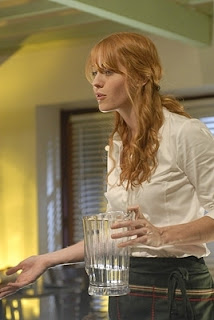 |
| Tamara Jolaine as Erin |
You need to stop … You do not get to put that on me. I’m not some experiment for you to prove your manhood, Jason. This is my body. I am going to make the ultimate decision.
Erin pinpoints the way women’s bodies are so often used as battlegrounds for men trying to advance an agenda, personal or political. Jason’s injury has made him so desperate for a chance to be strong and important and yes, masculine again, that he loses any sense that she is a person, too. Jason can’t control his own body, so he wants to control hers.
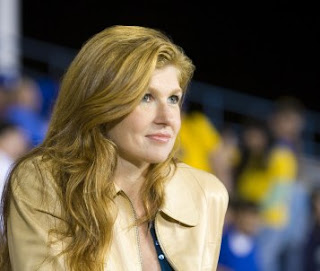 |
| Connie Britton as Tami Taylor |
“How pregnant do you want to be? Because you’re extremely pregnant.”
When Tami looks less than happy about the news, Corinna asks her, “Do you want to be pregnant?” A teary-eyed Tami responds:
Do I want to be pregnant? Do I want to be pregnant? I don’t know. […] We planned it, like, thirteen years ago. And then twelve years ago, and then eleven years ago, and then ten years ago.
The show skips most of Tami’s actual pregnancy (it occurs during the break between the first and second seasons), but picks up the story and closely follows her experience as a new mother, even if it is her second time around. With all her privilege and advantages, balancing work, family, and her own personal life is still a challenge. Her teenage daughter proves less than supportive, her husband is largely absent due to work, and she certainly could have benefited from some on-site childcare when she returns to her job at the school. Overall, Friday Night Lights does an excellent job of portraying a family that believed it was complete dealing with an unplanned pregnancy and a new baby.
We don’t have any money. I’m in the 10th grade, and it’s my first time. And I threw it way, and I don’t want to throw my life away. It’s just really obvious that my mom wants me to have this abortion. Because I was her mistake and she has just struggled and hurt everyday, and she wanted better and I knew better. And then I was just thinking, you know, forget what she wants, like, what do I want? And maybe I could take care of this baby, and maybe I would be good at it, and I could love it and I would be there for it. And then I was just thinking how awful it would be if I had the baby and then I spent the rest of my life resenting it, or her.
Those around her (her mother, the mother of the baby’s father, the community) seem more upset and emotionally reactionary than Becky herself. It also seems that the extreme reactions of those around her affect her more than the abortion itself […] Abortion, it would seem, is not the issue; the hysteria surrounding it is.
